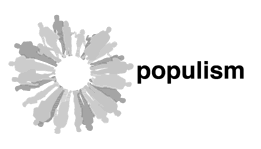Politics and Promises
by Vanessa Joan Müller
The term populism, usually associated with right-wing political parties, has all of a sudden taken on new shades of meaning just before the German federal elections in September. Unemployment, taxes, health insurance, and social justice are just a few of the topics the media and politicians have been talking about this campaign season. But it is not only about telling the people the truth about the current crisis in the German economy and the effects this crisis will cause. The established parties are having to face a new competitor: the Party of Democratic Socialism (the "PDS," the successor party to East Germany’s former ruling party, the SED) and the newly founded Labour and Social Justice Party (the "WASG") have agreed to enter into an electoral alliance called the Left Party. WASG is a party headed by former SPD leader Oskar Lafontaine and was formed by breakaway elements within the SPD who were angered at that party's direction regarding economic reform. What the Left Party promises is populism at its best: simplified responses to a complex situation. Germany has four million unemployed people and an economical growth of zero percent. The federal budget runs a deficit of about 50 billion Euros per year; reforms of the health and pension system are urgent tasks. For the Left Party, these problems are mainly the result of globalization, which they consider a new ideology of the “capitalists.” As a result, the Left Party has promised a guaranteed minimum wage of 1200 Euro per month for everyone, financed by higher taxes for the rich. The party's economic ideas include raising corporate taxes, a shortening of the workweek, bringing back a tax on stock market transactions, and raising inheritance and gift taxes. They want to defend the rights of the “working class” against greedy multinational mergers. Due to their populist rhetoric, “capitalist” – a term almost forgotten in political discussion – would seem to be the mot du jour , and video installations in the “Populism” exhibition like Milica Tomic’s Reading Capital or Julika Rudelius’ Economic Primacy draw special attention to visitors who will recognize striking parallels to the daily news coverage.
But it is not only the “capitalist,” who has seen a revival in this pre-election German summer. Edmund Stoiber, the leader of the CSU (the Bavarian wing of the German conservatives), officially stated that he does not accept that the “East” will again decide who will be Germany's chancellor. „It cannot be allowed that 'the frustrated' determine Germany's fate,“ he told a group of supporters and regretted that people in Germany are not everywhere "so intelligent as in Bavaria." Stoiber’s comments made the economic and social problems of eastern Germany and the mutual suspicion felt by west and east Germans become another major issue in the German election campaign. All of a sudden (or maybe just more visibly than before) the gap between east and west Germany is a number one topic again. But if you take a look at the Populism exhibition in Frankfurt, it is quite obvious that this distinction between East and West has been a popular argument for politicians and media for quite a while. Petra Bauer’s video Der Fall Joseph, for example, investigates a story which is still very familiar to a German audience: the tragic death of a young boy in a small town in eastern Germany, whose parents suspect that neo-Nazis had killed him. Politicians from all parties visited Joseph’s hometown to give their condolences to the parents while condemning the right-wing youth of the East. In the end, things turned out to be rather different than the populist suspicion – right-wing youngsters kill child from multi-cultural family. The little town in eastern Germany disappeared from the political agenda as quickly as it had appeared. The prejudice, though, which caused this media attention – followed by politicians fishing for voters’ support – was never questioned.
Some of the reviews of the “Populism” exhibition criticized the connection between some the works on display and the theme of populism as being obscure. Others find it difficult to define the term as reflected by the artists and their individual approach to popularity and populism. Talking to people who have seen the show, however, proves something different. The videos, photos, and installations are poignant indicators about the current situation in a country where popular rhetoric is widespread (politicians, after all, want to be re-elected). With the growing conflicts between “the rich” and “the poor” (we are realizing that the end of the welfare state happened some years ago already) and unpopular reforms, no political party wants to put these issues into their official agenda, although everybody knows that it can’t go on like this any more. At the moment, the atmosphere is one of politics and promises – hence, a perfect time for an exhibition called “Populism.” At least that’s one thing everybody can agree upon.
|



